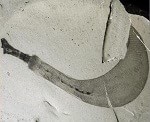Scientists have discovered a new species of Penis Worm, a fearsome penis-shaped beast that existed 500 million years ago. It could turn its mouth inside out, revealing a tooth-lined throat resembling a cheese grater.
Some species of Penis Worm (Ottoia) still exist today. However, during the Cambrian period they were among the most common lifeforms on Earth, and are preserved in huge numbers in the Burgess Shale, a famous fossil deposit in the Canadian Rockies.
Five hundred million years ago, penis worms were voracious predators, preying on virtually anything that crossed their paths, including shrimp, worms and other marine creatures.

(Left) Illustration of Ottoia, a prehistoric priapulid, burrowing. (Right) Ottoia worm. (Image: University of Cambridge)
Their teeth were not just used for eating. When it turned its mouth inside out, the penis worm could use its teeth to hook onto a surface and then pull the rest of its body along behind.
Microscopic teeth
In this latest study, published in the academic journal Palaeontology, the scientists explain that they had to use high-powered microscopes to learn more about the penis worms’ teeth, given that they are less than one millimeter in size.
Lead author, Dr. Martin Smith, Junior Research Fellow at the University of Cambridge’s Department of Earth Sciences, and colleagues found that the teeth had a scaly base and were fringed with minuscule hairs and prickles.
By reconstructing what Ottoia’s teeth looked like, the team discovered fossil teeth from several previously unrecognized penis worm species all over the world.
These Cambrian priapulids’ (penis worms’) teeth had different shapes according to their function. Some were shaped like a city skyline, some like a cone fringed with tiny hairs and prickles, while others looked like a bear claw.
During the Cambrian era, the majority of animals were soft-bodied, like sponges and worms. Therefore, apart from very special places where conditions are just right to enable preservation of soft-bodied creatures, it is virtually impossible to know how far certain species were distributed across the world during that period.

Different shaped teeth, according to function. (Credit: Tom Harvey. Image source: news.sciencemag.org)
Compiling a ‘dentist’s handbook’
Dr. Smith said:
“Taken together, our study has allowed us to compile a ‘dentist’s handbook’ that will help paleontologists recognize a range of early teeth preserved in the fossil record.”
After examining dental imprints left behind in the rocks, the researchers concluded that the most common groups of penis worm – Ottoia prolifica – should really be two separate species.
Dr. Smith and colleagues proposed the name O. tricuspida for the newly-discovered species, to reflect the three-pronged tooth that makes it unique compared to its cousins.
Due to the small difference, the researchers believe that several fossils previously classed as O. prolifica may, in fact, belong to O. tricuspida, suggesting that one of the most common and ecologically important animals of the Cambrian era might be more diverse that previously thought.
Dr. Smith said:
“Modern penis worms have been pushed to the margins of life, generally living in extreme underwater environments. But during the Cambrian, they were fearsome beasts, and extremely successful ones at that.”
The study was funded by the Natural Environment Research Council, the Palaeontological Association, and Clare College, Cambridge.

